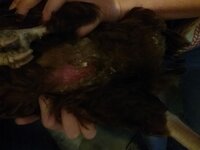A & H
Songster
Hey all,
It's winter over here in idaho, and I have two hens. One is a Rhode island red, the other an Americana. Recently I noticed a patch on my Rhode island's belly sort of between her legs. It's not filled with fluid or anything, it's just red and featherless The feathers are broken off around there. We don't have roosts in the coop, but they have never had this issue before. One of my hens had to be put down because of mites, but i dont see anything on the live one. I have dusted, just in case. Both hens look healthy, red comb, eating, drinking, etc. They greet me eagerly and walk normally. Please tell me if you know of a problem like this or is it not a big deal??? Thanks guys!
It's winter over here in idaho, and I have two hens. One is a Rhode island red, the other an Americana. Recently I noticed a patch on my Rhode island's belly sort of between her legs. It's not filled with fluid or anything, it's just red and featherless The feathers are broken off around there. We don't have roosts in the coop, but they have never had this issue before. One of my hens had to be put down because of mites, but i dont see anything on the live one. I have dusted, just in case. Both hens look healthy, red comb, eating, drinking, etc. They greet me eagerly and walk normally. Please tell me if you know of a problem like this or is it not a big deal??? Thanks guys!




